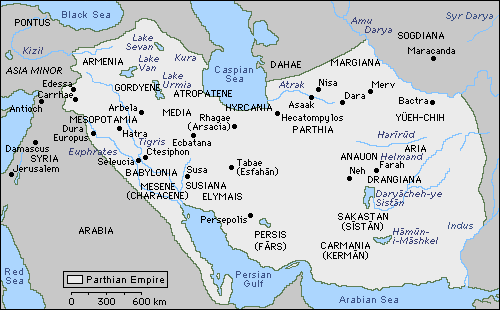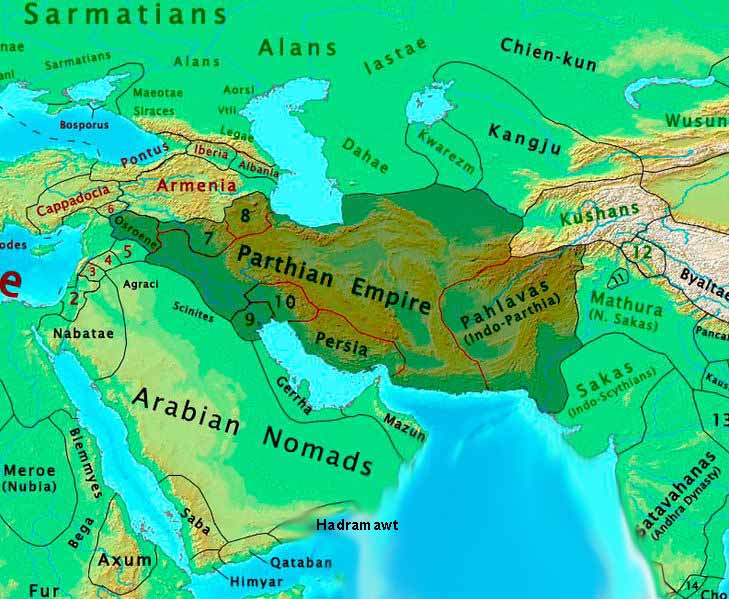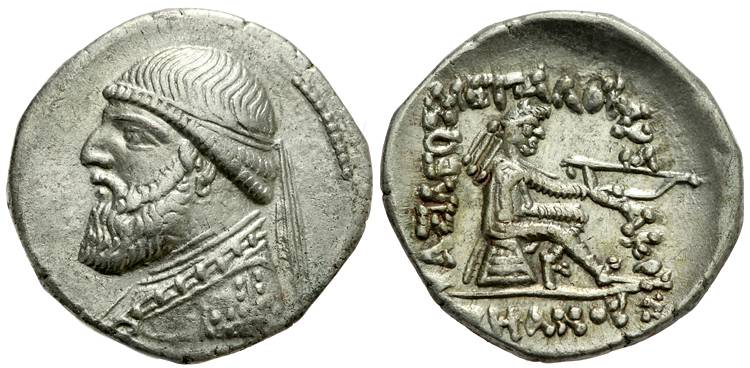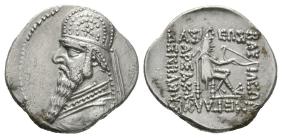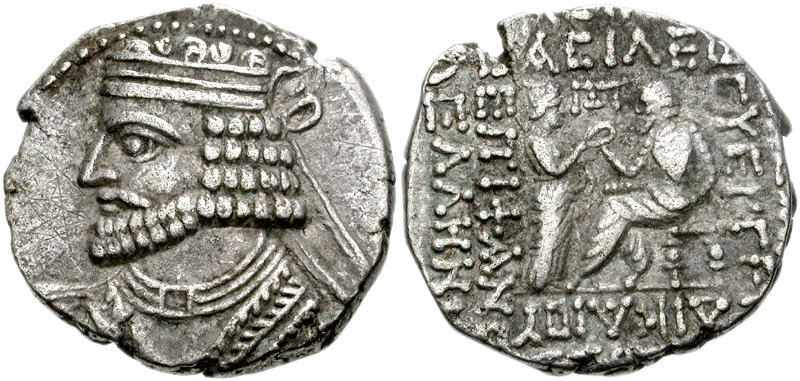5.1. GENERAL OVERWIEV OF THE ARSACID MILITARY.
Any polity based in the Iranian plateau had to defend a country that stood in an exposed central position, and which can be attacked from almost all sides. Fortunately for the Arsacids and Sasanians, nature had lend them a hand in this in the form of natural barriers, especially in the west and north-west, although these natural barriers left unprotected and exposed to invasion some of the richest territories of the empire (Mesopotamia and Elymais).
Still, the Iranian empires found themselves in the hardly enviable position of having to defend themselves on west and east against empires must vaster and richer in manpower and economic resources than themselves, plus the occasional nomadic invasion from the Caucasus or Central Asia. And then there was the added complication of the quarrels between the magnates about strategic priorities.
This situation, together with the traditions inherited from both the Parni and the ones that already existed in the Iranian plateau and which dated back to Achaemenid times, gave form to the Arsacid military.
The Arsacid and Sasanian armies were cavalry-based armies, with infantry playing a secondary role (although there were sources of good quality infantry in Iran, especially among the mountain tribes), which were essential in order to be assembled and move quickly to the threatened areas, as well as to be shifted from one border to another. Then there was also the manpower question: Iran had small demographic resources, but it needed to mobilize large armies; this was achieved by a thorough militarization of society, centered around the great warlike Parthian clans, capable of rising massive levies among their subjects, as well as by the temporary resource to foreign mercenaries or allies (often they were one and the same).
For the following evaluation of the strength of the Arsacid armies (which would be essentially the same as those available to the early Sasanians), I will follow the article manpower
Resources and Army Organization in the Arsakid Empire by Professor Marek Jan Olbrycht from the University of Rzeszów, published in
Ancient Society, No.46 (2016).
In the Abstract, Olbrycht states his conclusions: that the total military potential available to the Arsacid kings amounted to about 300,000 soldiers, with the maximum number of soldier available in a single army in any given time amounting to 120,000 – 150,000 men.
Those are huge numbers. For a comparison, the whole Roman army under Augustus is estimated to have amounted to 250,000 men, rising to 360,000-380,000 under Trajan and reaching a peak of 450,000 under Septimius Severus. It’s possible that later in the III century it reached even higher numbers nearing 500,000 men. And all this considering that at its peak, before the Antonine Plague, Belloch estimated the total population of the Roman empire at 61,4 million people (other scholars give somewhat higher estimates, but the usual consensus seems to oscillate between Belloch’s number and 75 million). The comparison (soldiers / inhabitants) between both empires is staggering.
Where does Olbrycht obtain these numbers from? Basically, through two methods: ancient sources and comparison with the (better documented) Achaemenid and Sasanian militaries.
The Roman historian Justin (II c. CE) stated that Frahād IV opposed Mark Antony’s invasion with an army of 50,000 cavalrymen. While the Greek historian Plutarch (II c. CE) when dealing about the same campaign states that a Parthian corps of 40,000 men annihilated Statianus’ supply train while another army totaling at least 40,000 men defended Phraaspa and other strongholds in Atropatene against Mark Antony’s main army. According to Tacitus, Walaxš I offered Vespasian an army of 40,000 men to help him in his fight against Vitellius.
Porphyrios of Tyre (III c. CE) stated that Frahād I (132-127 BC) opposed the invasion of the Seleucid king Antiochos VII Sidetes with and army of 120,000 men. In Sima Qian’s
Shiji, we’re informed that when Han envoys reached the eastern Parthian border around 110 BCE, they were escorted to Mihrdad II’s residence at Hekatompylos by a force of 20,000 cavalrymen. In the Syriac Chronicle of Arbela (a not too reliable source, though) it’s again stated that Walaxš IV (192-207 CE) campaigned against his rebellious Medes and Persian subjects with an army of 120,000 men. Thus, several ancient sources seem to agree about the huge numbers of soldiers available to the Arsacid kings.
The most reliable source for the organization of Arsacid armies of this era is the Armenian historian Moses of Khoren (V c. CE), who wrote about the organization of Armenian armies under the reign of Walaxš I of Armenia (51-79 CE); as Armenian armies were fairly identical in organization to Iranian ones, it’s quite safe to assume that the same organization applies to both cases. Arsacid armies were organized following a decimal system, that already existed under the Achaemenids and was kept under the Sasanians. The basic fighting unit was a “battalion” of 1,000 men, organized around a standard in the form of a dragon;
drafš in Parthian, which gave its name to the unit. 10
drafš formed a corps, called
gund.
If we look at army sizes under the Sasanians, we get that most usual armies oscillated between 20,000 and 40,000 soldiers, but that exceptionally they could be much larger. In 530 CE, two Sasanian armies operated separately in Mesopotamia totaling 80,000 men (according to Procopius). And in 579 CE, Hormozd IV mustered two armies against the Turks in Central Asia amounting to 82,000 men (according to Tabarī). Sebeos gives a number of 80,000 Sasanian soldiers at Qādisiyyah (636 CE), and numbers oscillating between 50,000 and 150,000 are given for the Sasanian army at Nehāvand in 642 CE (the highest number is given by Tabarī).
In light of these numbers, Olbrycht considers that the usual size for an Arsacid royal army (when led by the king in person) must’ve been around 50,000 men.
Olbrycht proposes the following composition for Arsacid armies:
- A permanent army, formed by the royal guard units, the garrisons in major cities and fortresses and governors’ troops in the provinces.
- The royal levy, levied from all the lands under direct rule of the Arsacid Šahanšah, including troops from the royal domains and the armies raised by the magnates. Olbrycht calls these forces (the quotation marks are his) a “Parthian national army”, levied amongst the mass of the Iranian population.
- The armies of the vassal kingdoms (Pārs, Armenia, Adiabene, Hatra, etc.).
- Mercenaries.
- Allies, often indistinguishable from mercenaries.
Of these forces, the largest and most important part was the royal levy. The permanent army must have been much smaller. And the difference with the Roman army is striking, because the Romans maintained at all times a massive permanent professional army paid by the state’s treasury. For the permanent royal army, Olbrycht estimates a number of 20,000 men, which compared to Rome’s permanent army is insignificant.
Tacitus’ description of the Arsacid army under Walaxš I mostly agrees with Olbrycht’s structure: a royal guard which was formed mostly by cavalry, auxiliaries from allied or vassal kings, and the royal levy, which Tacitus calls
moles. Tacitus and Plutarch also speak of a royal guard for the cases of Frahād IV and Ardawān II. According to Achaemenid precedents and Sasanian later practices, Olbrycht estimates that of the 20,000 men of the permanent army, between 6,000 and 10,000 must have belonged to the royal guard.
As for mercenaries, the Arsacid kings had several sources available to them: Sakas from the east, other nomads from Central Asia, Alans from the Caucasian steppe, and the many mountain peoples within the empire (Cadusians, Daylamites, Mardians, Kyrtians …) or allies (Iberians, Albanians, etc). A practice employed by the Arsacids (and by the Romans) was to recruit into their armies vanquished foes as mercenaries. This is specifically stated for the Greek/Macedonian soldiers of the defeated army of Antiochos VII Sidetes, and Olbrycht raises the possibility that a similar deal was offered to Roman prisoners like the ones taken at Carrhae.
As for the royal levy, it was raised among the
āzādān, the “free men” or warrior estate of the Iranian plateau. Of them, those who could afford a horse (magnates and lesser nobles) formed the “equestrian estate” (Parthian
asbārān). Freemen who were townsmen or peasants could also be recruited, and the nobility could also take their “serfs” with them.
Military service was compulsive for the nobility and part of the commoners. In particular among the nobility, war training began at a very early age, and carried onto until the boy reached manhood, leading to high standards of military prowess. Olbrycht provides some quotes from Justin, Herodian, Cassius Dio and Ammianus Marcellinus in this respect.
When dealing with the mobilization strengths available to the several parts of the empire, Olbrycht uses the accounts of Polybius, Strabo and Plutarch. Neither of them though gives numbers, so he supports his estimates by drawing a direct comparison with the forces raised from the Achaemenid satrapies, as listed by the Roman historian Quintus Curtius Rufus (I c. CE). The estimates by Olbrycht are as follows:
Lands under direct Arsacid royal rule:
- Greater Media: 30,000 infantry and 20,000 cavalry.
- Parthia: 40,000 cavalry and 10,000 infantry.
- Hyrcania, Areia and Margiana: at least 30,000 men, between infantry and cavalry.
- Sakastan: “at least” 15,000 cavalrymen.
- Carmania: 15,000 men, mostly infantry.
- Susiana (part of Xuzestān, under direct royal rule): 10,000 men, mostly infantry.
- Babylonia and Mesopotamia (urban militias and Jewish contingents under their own commanders): 10,000 men, almost all of them infantry.
This adds up to 180,000 men, half of whom were cavalry. To it Olbrycht adds the permanent royal army of 20,000 (mostly cavalry), and the forces of Media Atropatene (40,000 infantry and 10,000 cavalry) that from Ardawān II onwards were part of the royal domain. So, Olbrycht reaches a number of 250,000 available soldiers.
When it comes to an estimate of the forces provided by the vassal kingdoms and allies Olbrycht gives the following numbers:
- Armenia: 46,000 men, 16,000 of whom were cavalry.
- Elymais: 10,000 infantry.
- Iberia: 30,000 infantry, 10,000 cavalry.
- Albania: 30,000 infantry, 10,000 cavalry.
- (NOTE: Iberia and Albania were allied kingdoms under Arsacid influence, but not vassals)
- Adiabene: 6,000 cavalry and 4,000 infantry.
- Pārs: 50,000 men (Olbrycht does not break this number down into cavalry and infantry).
Olbrycht though makes clear that these totals were just
available totals, and that the largest number ever mentioned for a single Arsacid army by ancient authors is 120,000, which was also the number quoted by Xenophon in his
Cyropaedia for the “Persian army”, and is also given by Arrian in his
Anabasis of Alexander.
The royal domains were divided into military provinces, each of which was led by a
strategos (Greek term used in several Greek inscriptions across Iran) or
marzbān (Parthian word that appears in the texts of Old Nisa). This latter term is also attested during all the Sasanian era.
It’s worth noticing that after Crassus’ defeat at Carrhae (in which he’d invaded with an army of 50,000 men), in all the subsequent Roman full-on assaults against Parthians, the size of their armies increased considerably; 16 legions and 10,000 cavalry for Julius Caesar’s planned expedition, more than 100,000 men for Mark Antony’s expedition, 80,000 men for Trajan’s invasion (according to Bennet’s biography of Trajan), 200,000 men Lucius Verus (according to Yann Le Bohec) and 150,000 for Septimius Severus (according again to Le Bohec).


